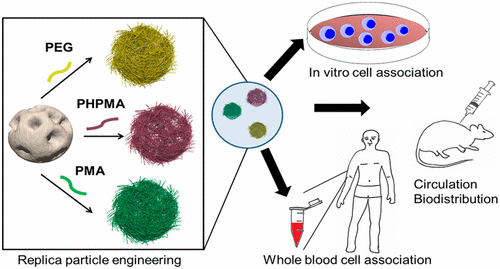当前位置:
X-MOL 学术
›
ACS Appl. Mater. Interfaces
›
论文详情
Our official English website, www.x-mol.net, welcomes your feedback! (Note: you will need to create a separate account there.)
Templated Polymer Replica Nanoparticles to Facilitate Assessment of Material-Dependent Pharmacokinetics and Biodistribution
ACS Applied Materials & Interfaces ( IF 9.5 ) Pub Date : 2017-09-25 00:00:00 , DOI: 10.1021/acsami.7b11579 Danzi Song 1 , Jiwei Cui 1 , Huanli Sun 1 , Tri-Hung Nguyen 2 , Sheilajen Alcantara 3 , Robert De Rose 3 , Stephen J. Kent 3, 4 , Christopher J. H. Porter 2 , Frank Caruso 1
ACS Applied Materials & Interfaces ( IF 9.5 ) Pub Date : 2017-09-25 00:00:00 , DOI: 10.1021/acsami.7b11579 Danzi Song 1 , Jiwei Cui 1 , Huanli Sun 1 , Tri-Hung Nguyen 2 , Sheilajen Alcantara 3 , Robert De Rose 3 , Stephen J. Kent 3, 4 , Christopher J. H. Porter 2 , Frank Caruso 1
Affiliation

|
Surface modification is frequently used to tailor the interactions of nanoparticles with biological systems. In many cases, the chemical nature of the treatments employed to modify the biological interface (for example attachment of hydrophilic polymers or targeting groups) is the focus of attention. However, isolation of the fundamental effects of the materials employed to modify the interface are often confounded by secondary effects imparted by the underlying substrate. Herein, we demonstrate that polymer replica particles templated from degradable mesoporous silica provide a facile means to evaluate the impact of surface modification on the biological interactions of nanomaterials, independent of the substrate. Poly(ethylene glycol) (PEG), poly(N-(2 hydroxypropyl)methacrylamide) (PHPMA), and poly(methacrylic acid) (PMA) were templated onto mesoporous silica and cross-linked and the residual particles were removed. The resulting nanoparticles, comprising interfacial polymer alone, were then investigated using a range of in vitro and in vivo tests. As expected, the PEG particles showed the best stealth properties, and these trends were consistent in both in vitro and in vivo studies. PMA particles showed the highest cell association in cell lines in vitro and were rapidly taken up by monocytes in ex vivo whole blood, properties consistent with the very high in vivo clearance subsequently seen in rats. In contrast, PHPMA particles showed rapid association with both granulocytes and monocytes in ex vivo whole blood, even though in vivo clearance was less rapid than the PMA particles. Rat studies confirmed better systemic exposure for PEG and PHPMA particles when compared to PMA particles. This study provides a new avenue for investigating material-dependent biological behaviors of polymer particles, irrespective of the properties of the underlying core, and provides insights for the selection of polymer particles for future biological applications.
中文翻译:

模板化的聚合物复制品纳米颗粒,以方便评估材料依赖的药代动力学和生物分布。
表面修饰通常用于调整纳米粒子与生物系统的相互作用。在许多情况下,用于修饰生物学界面(例如亲水性聚合物或靶向基团的连接)的处理方法的化学性质是关注的焦点。然而,用于修饰界面的材料的基本作用的隔离常常被下面的基底所赋予的次要作用所混淆。在这里,我们证明了以可降解的中孔二氧化硅为模板的聚合物复制品颗粒提供了一种简便的方法来评估表面改性对纳米材料生物相互作用的影响,而与基材无关。聚(乙二醇)(PEG),聚(N将-(2-羟丙基)甲基丙烯酰胺)(PHPMA)和聚(甲基丙烯酸)(PMA)模板化到中孔二氧化硅上并进行交联,除去残留的颗粒。然后使用一系列体外和体内试验研究所得的仅包含界面聚合物的纳米颗粒。正如预期的那样,PEG颗粒显示出最佳的隐形性能,并且这些趋势在体外和体内研究中均一致。PMA颗粒在体外细胞系中显示出最高的细胞缔合,并被离体全血中的单核细胞迅速吸收,其特性与随后在大鼠中观察到的很高的体内清除率相符。相反,PHPMA颗粒在离体全血中显示出与粒细胞和单核细胞的快速缔合,即使体内清除速度不如PMA颗粒快。大鼠研究证实,与PMA颗粒相比,PEG和PHPMA颗粒具有更好的全身暴露。这项研究为研究聚合物颗粒的材料依赖性生物学行为提供了新途径,而与基础核的性质无关,并为选择聚合物颗粒提供了见识,以用于未来的生物学应用。
更新日期:2017-09-25
中文翻译:

模板化的聚合物复制品纳米颗粒,以方便评估材料依赖的药代动力学和生物分布。
表面修饰通常用于调整纳米粒子与生物系统的相互作用。在许多情况下,用于修饰生物学界面(例如亲水性聚合物或靶向基团的连接)的处理方法的化学性质是关注的焦点。然而,用于修饰界面的材料的基本作用的隔离常常被下面的基底所赋予的次要作用所混淆。在这里,我们证明了以可降解的中孔二氧化硅为模板的聚合物复制品颗粒提供了一种简便的方法来评估表面改性对纳米材料生物相互作用的影响,而与基材无关。聚(乙二醇)(PEG),聚(N将-(2-羟丙基)甲基丙烯酰胺)(PHPMA)和聚(甲基丙烯酸)(PMA)模板化到中孔二氧化硅上并进行交联,除去残留的颗粒。然后使用一系列体外和体内试验研究所得的仅包含界面聚合物的纳米颗粒。正如预期的那样,PEG颗粒显示出最佳的隐形性能,并且这些趋势在体外和体内研究中均一致。PMA颗粒在体外细胞系中显示出最高的细胞缔合,并被离体全血中的单核细胞迅速吸收,其特性与随后在大鼠中观察到的很高的体内清除率相符。相反,PHPMA颗粒在离体全血中显示出与粒细胞和单核细胞的快速缔合,即使体内清除速度不如PMA颗粒快。大鼠研究证实,与PMA颗粒相比,PEG和PHPMA颗粒具有更好的全身暴露。这项研究为研究聚合物颗粒的材料依赖性生物学行为提供了新途径,而与基础核的性质无关,并为选择聚合物颗粒提供了见识,以用于未来的生物学应用。



























 京公网安备 11010802027423号
京公网安备 11010802027423号